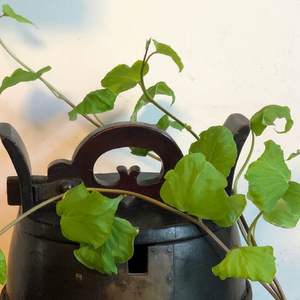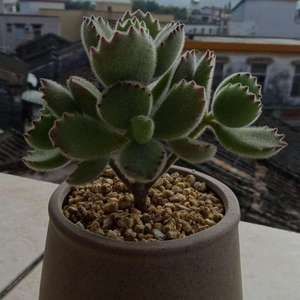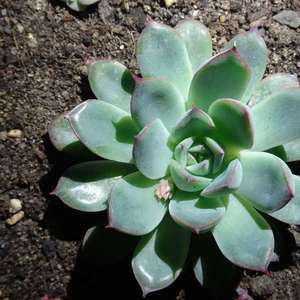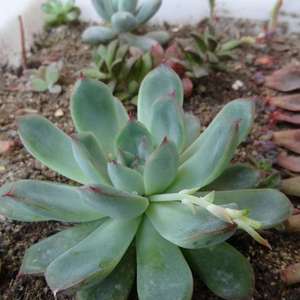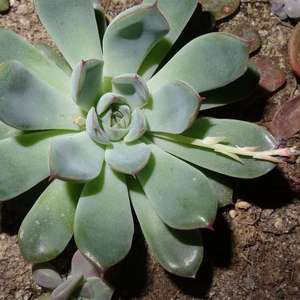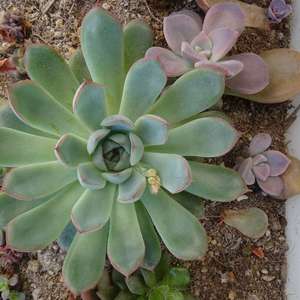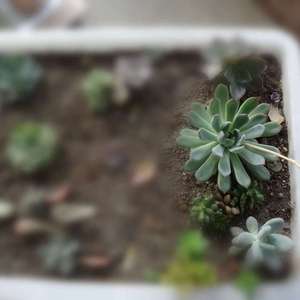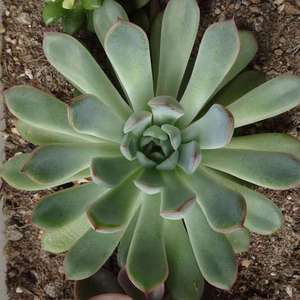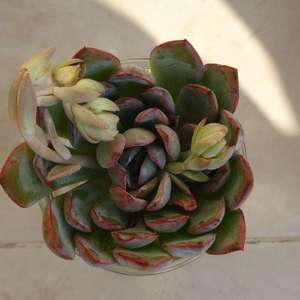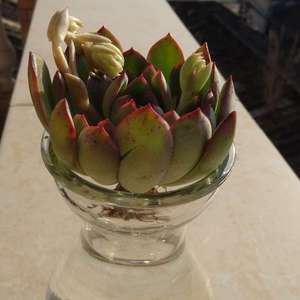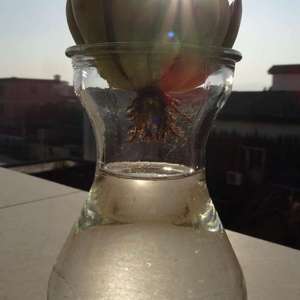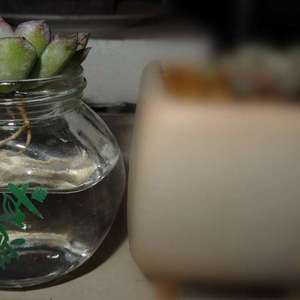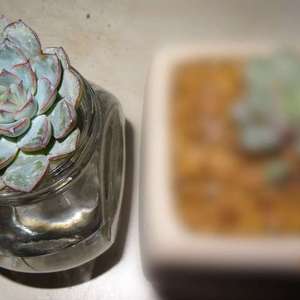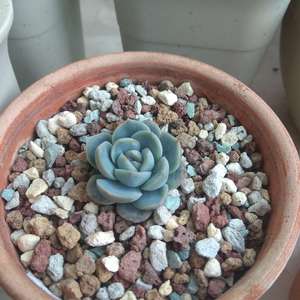文章
Miss Chen
2018年06月11日

Description: This annual plant is about 2–3½' tall, branching occasionally. The stems are light green, reddish green, or brown; they are often ribbed and slightly to moderately hairy. The opposite compound leaves are simple-pinnate, becoming smaller as they ascend the stems. These compound leaves are up to 10" long and 6" across; they consist of 3-5 leaflets and have petioles up to 2" long. The leaflets are up to 3" long and 1" across; they are lanceolate or narrowly ovate, coarsely toothed along the margins, and hairless. These leaflets have short petioles (petiolules) or they are sessile. In addition to the opposite compound leaves, some of the upper leaves may be alternate and simple.
The upper stems terminate in a single flowerhead on a long slender stalk (peduncle). This flowering stalk is more or less hairy and may have 1 or 2 simple leaves up to 1½" long. The flowerhead is about ¾–1" across and it is subtended by 11-20 leafy bracts. These bracts are oblanceolate to linear in shape and ciliate along their margins. The flowerhead contains several tiny florets that are tightly bunched together. Each yellow disk floret is tubular in shape with 5 tiny teeth along its upper rim. The ray florets are insignificant. The blooming period occurs from late summer to fall and lasts about 1-2 months. There is no noticeable floral scent. The florets are replaced by achenes up to ¼" long. These achenes are initially yellow-green in color, but they eventually become dark brown. Each achene is oblong and flattened; it is a little broader toward the top than the bottom. At the apex of each achene, there is a pair of slender barbed awns. The root system is strongly branched and rather shallow. This plant reproduces by its achenes only.
Cultivation: The preference is full sun to light shade, wet to moist conditions, and a loamy or silty soil. Soil fertility and moisture availability can significantly influence the size of individual plants. Occasionally, the leaves are disfigured by various kinds of disease later in the year.

Range & Habitat: The native Tall Beggar's Ticks is an occasional plant that occurs in most areas of Illinois; it is uncommon or absent in the southwestern and north-central areas of the state (see Distribution Map). Habitats include openings in moist woodlands, woodland borders, areas adjacent to woodland paths, thickets and meadows in floodplain areas, marshes and seasonal wetlands, drainage ditches, and waste areas. Tall Beggar's Ticks is found in wooded areas to a greater extent than other Bidens spp., although it also occurs in sunny wetlands. Disturbed areas are strongly preferred; this species is rather weedy.
Faunal Associations: The flowers aren't very showy and attract few insect visitors. Occasionally, various bees and flies suck nectar from the disk florets. Pollen may be an occasional source of food for some of these insects. The caterpillars of the butterfly Nathalis iole (Dainty Sulfur) feed on the foliage of Bidens spp., as do the caterpillars of several moth species, including Cirrhophanus triangulifer (Goldenrod Stowaway), Epiblema otiosa (Bidens Borer Moth), Condica confederata (The Confederate), Palthis asopialis (Faint-Spotted Palthis), and Platysenta mobilis (Mobile Groundling). Various birds eat the seeds of Bidens spp. to a limited extent, including the Mallard, Ring-Necked Pheasant, Bobwhite Quail, Purple Finch, Common Redpoll, and Swamp Sparrow. The Cottontail Rabbit eats the foliage of Bidens spp. to a limited extent. The barbed achenes cling readily to the fur of mammals and the clothing of humans, which helps to distribute them into new areas.

Photographic Location: A roadside ditch along a wooded area near Judge Webber Park in Urbana, Illinois.
Comments: Tall Beggar's Ticks is often confused with Bidens frondosa (Common Beggar's Ticks) because of their similar appearance. Both species have non-showy flowerheads and they have compound leaves that are simple-pinnate. However, Tall Beggar's Ticks has 11-20 leafy bracts that surround each flowerhead, while Common Beggar's Ticks has only 7-10 leafy bracts per flowerhead. It is easy to see that the flowerhead in the upper photograph has more than 10 leafy bracts. Another species, Bidens discoidea, has even fewer leafy bracts than Common Beggar's Ticks. The barbed achenes of Tall Beggar's Ticks are very similar in appearance to those of Common Beggar's Ticks, although they are slightly larger in size. Other Bidens spp. in Illinois differ from the preceding species because they have showy flowerheads with conspicuous ray florets, and/or they have either simple leaves or compound leaves that are double-pinnate. Notwithstanding its common name, Tall Beggar's Ticks isn't substantially taller than Common Beggar's Ticks and many other Bidens spp.
The upper stems terminate in a single flowerhead on a long slender stalk (peduncle). This flowering stalk is more or less hairy and may have 1 or 2 simple leaves up to 1½" long. The flowerhead is about ¾–1" across and it is subtended by 11-20 leafy bracts. These bracts are oblanceolate to linear in shape and ciliate along their margins. The flowerhead contains several tiny florets that are tightly bunched together. Each yellow disk floret is tubular in shape with 5 tiny teeth along its upper rim. The ray florets are insignificant. The blooming period occurs from late summer to fall and lasts about 1-2 months. There is no noticeable floral scent. The florets are replaced by achenes up to ¼" long. These achenes are initially yellow-green in color, but they eventually become dark brown. Each achene is oblong and flattened; it is a little broader toward the top than the bottom. At the apex of each achene, there is a pair of slender barbed awns. The root system is strongly branched and rather shallow. This plant reproduces by its achenes only.
Cultivation: The preference is full sun to light shade, wet to moist conditions, and a loamy or silty soil. Soil fertility and moisture availability can significantly influence the size of individual plants. Occasionally, the leaves are disfigured by various kinds of disease later in the year.

Range & Habitat: The native Tall Beggar's Ticks is an occasional plant that occurs in most areas of Illinois; it is uncommon or absent in the southwestern and north-central areas of the state (see Distribution Map). Habitats include openings in moist woodlands, woodland borders, areas adjacent to woodland paths, thickets and meadows in floodplain areas, marshes and seasonal wetlands, drainage ditches, and waste areas. Tall Beggar's Ticks is found in wooded areas to a greater extent than other Bidens spp., although it also occurs in sunny wetlands. Disturbed areas are strongly preferred; this species is rather weedy.
Faunal Associations: The flowers aren't very showy and attract few insect visitors. Occasionally, various bees and flies suck nectar from the disk florets. Pollen may be an occasional source of food for some of these insects. The caterpillars of the butterfly Nathalis iole (Dainty Sulfur) feed on the foliage of Bidens spp., as do the caterpillars of several moth species, including Cirrhophanus triangulifer (Goldenrod Stowaway), Epiblema otiosa (Bidens Borer Moth), Condica confederata (The Confederate), Palthis asopialis (Faint-Spotted Palthis), and Platysenta mobilis (Mobile Groundling). Various birds eat the seeds of Bidens spp. to a limited extent, including the Mallard, Ring-Necked Pheasant, Bobwhite Quail, Purple Finch, Common Redpoll, and Swamp Sparrow. The Cottontail Rabbit eats the foliage of Bidens spp. to a limited extent. The barbed achenes cling readily to the fur of mammals and the clothing of humans, which helps to distribute them into new areas.

Photographic Location: A roadside ditch along a wooded area near Judge Webber Park in Urbana, Illinois.
Comments: Tall Beggar's Ticks is often confused with Bidens frondosa (Common Beggar's Ticks) because of their similar appearance. Both species have non-showy flowerheads and they have compound leaves that are simple-pinnate. However, Tall Beggar's Ticks has 11-20 leafy bracts that surround each flowerhead, while Common Beggar's Ticks has only 7-10 leafy bracts per flowerhead. It is easy to see that the flowerhead in the upper photograph has more than 10 leafy bracts. Another species, Bidens discoidea, has even fewer leafy bracts than Common Beggar's Ticks. The barbed achenes of Tall Beggar's Ticks are very similar in appearance to those of Common Beggar's Ticks, although they are slightly larger in size. Other Bidens spp. in Illinois differ from the preceding species because they have showy flowerheads with conspicuous ray florets, and/or they have either simple leaves or compound leaves that are double-pinnate. Notwithstanding its common name, Tall Beggar's Ticks isn't substantially taller than Common Beggar's Ticks and many other Bidens spp.
0
0
文章
Miss Chen
2018年06月11日

Description: This herbaceous plant is a summer annual about 1-2½' tall that branches occasionally to frequently. The terete to slightly angular stems are light green, purplish green, or purple, and they are glabrous. Pairs of opposite trifoliate leaves occur along these stems, although some of the uppermost leaves are usually simple and alternate. The trifoliate leaves are up to 4" long and 3" across in outline, while their petioles are up to 1½" long. The petioles are light green to purplish green and mostly glabrous, except for some sparse pubescence along the narrow grooves of their upper sides. The terminal leaflets are about 1½-2" long and ½-¾" across; they are narrowly lanceolate to lanceolate in shape and coarsely dentate along their margins. The petiolules (basal stalklets) of terminal leaflets are about ¾" long and slender. The lateral leaflets are about 1-1½" long and ½-¾" across; they are lanceolate in shape and coarsely dentate along their margins. The petiolules of lateral leaflets are very short (up to 3 mm. long). The upper surfaces of leaflets are medium green and glabrous, while their lower surfaces are pale green and glabrous (or nearly so). During autumn, the leaflets often turn purple in response to cold weather.
Upper stems terminate in either individual or small clusters of 2-3 flowerheads. The peduncles of these flowerheads are relatively short (up to 12 mm. or ½" long). Each flowerhead is about 3-6 mm. across (excluding the outer bracts), consisting of 10-20 disk florets and no ray florets. The corollas of disk florets are yellow, short-tubular in shape, and 5-lobed; they are about 3 mm. long. Originating from the base of each flowerhead, there are 2-5 leafy outer bracts. The outer bracts are medium green, narrowly oblanceolate or elliptic in shape, and glabrous (or nearly so); they are up to 1½" (4 cm.) long and 8 mm. across (usually about one-half the maximum size, but highly variable). Around the base of each flowerhead, there are several inner bracts. These inner bracts are 4-6 mm. long, light green or yellowish green, oblong-ovate in shape, and appressed together in a slightly overlapping single series. The blooming occurs from late summer into the fall, lasting about 1½-2 months. In the absence of cross-pollination, the disk florets are self-fertile. Afterwards, the disk florets are replaced by achenes with pairs of awns. The achenes (excluding their awns) are about 4 mm. long, 1-1.5 mm. across, and flattened-oblanceoloid in shape; they are truncate at their apices, while their outer sides have faint midribs. The barbed awns of these achenes (2 awns per achene) are about 1 mm. in length. Mature achenes are greenish brown to dark brown.

The root system is shallow and fibrous. This plant reproduces primarily by reseeding itself. The lower nodes of its stems can develop rootlets when they contact moist ground. Occasionally, colonies of plants of variable size will develop at favorable sites.
Cultivation: The preference is full or partial sun, wet to moist conditions, and soil containing loam or decaying organic material. Sometimes this plant establishes itself on fallen logs or the lower trunks of trees. Standing water is tolerated if it is temporary.
Range & Habitat: The native Swamp Beggar's Ticks is occasional in southern and central Illinois, while in the northern section of the state it is rare or absent (see Distribution Map). Habitats include swamps, banks of lakes, margins of ponds, low areas along rivers, and limestone sinkholes. This plant can be found in either disturbed or higher quality wetlands, favoring humid areas where there is some protection from the wind.

Faunal Associations: The non-showy flowerheads attract relatively few insect pollinators, although sometimes bees (including Halictid bees) and flies (including Syrphid, Tachinid, and bee flies) will either collect or feed on the nectar and pollen. In general, the foliage, stems, and other parts of Bidens spp. are a source of food for such insects as aphids (including Aphis coreopsidis & Brachycauda helichrysi), larvae of the fruit fly Icterica seriata, larvae of the leaf-mining flies Chromatomyia syngenesiae and Phytobia allecta, caterpillars of the butterfly Nathalis iole (Dainty Sulfur), larvae of several moths (including Cirrhophanus triangulifer and Epiblema otiosana), and leaf beetles (Calligrapha bidenticola & Calligrapha californica). See the Insect Table for a more complete listing of these species. The achenes or seedheads of Bidens spp. are consumed by some species of waterfowl, upland gamebirds, and songbirds, including the Mallard, Wood Duck, Greater Prairie Chicken, Ring-Necked Pheasant, Bobwhite Quail, Purple Finch, Common Redpoll, and Swamp Sparrow (Martin et al., 1951/1961; Havera, 1999; Schwartz, 1945). In addition, the Snapping Turtle (Chelydra serpentina), Blanding's Turtle (Emys blandingii), and the Painted Turtle (Chrysemys picta) sometimes feed on the seeds and possibly the foliage of these plants (Lagler, 1943; Ernst et al., 1994). The foliage is browsed sparingly by White-Tailed Deer and the Cottontail Rabbit. The awned achenes can cling to the feathers of birds, the fur of mammals, and the clothing of humans, which spreads Swamp Beggar's Ticks and other Bidens spp. to new locations.

Photographic Location: Border of a lake at Walnut Point State Park in Douglas County.
Comments: This is one of the Bidens spp. in Illinois with non-showy flowerheads because it lacks ray florets. Species in this group are often referred to as "Beggar's Ticks." Once the flowerheads are produced, Swamp Beggar's Ticks (Bidens discoidea) is fairly easy to distinguish from two similar species with 2-awned achenes, namely Common Beggar's Ticks (Bidens frondosa) and Tall Beggar's Ticks (Bidens vulgata). Most noticeably, the flowerheads of Swamp Beggar's Ticks have fewer outer bracts (typically 3-4) than those of Common Beggar's Ticks (typically 6-11) and Tall Beggar's Ticks (typically 13-20). In addition to having fewer outer bracts than these species, it also has smaller achenes with shorter awns. In contrast to the preceding species, other non-showy Bidens spp. in Illinois, such as Purple-Stemmed Tickseed (Bidens connata) and Three-Lobed Beggar's Ticks (Bidens comosa), can be distinguished from the preceding species by their 3- or 4-awned achenes. Sometimes Nodding Bur-Marigold (Bidens cernua) also lacks ray florets, but it has only simple leaves and its achenes are 4-awned. In comparison to the preceding Bidens spp., Swamp Beggar's Ticks has a rather delicate appearance because of its thin leaves and relatively small size.
Upper stems terminate in either individual or small clusters of 2-3 flowerheads. The peduncles of these flowerheads are relatively short (up to 12 mm. or ½" long). Each flowerhead is about 3-6 mm. across (excluding the outer bracts), consisting of 10-20 disk florets and no ray florets. The corollas of disk florets are yellow, short-tubular in shape, and 5-lobed; they are about 3 mm. long. Originating from the base of each flowerhead, there are 2-5 leafy outer bracts. The outer bracts are medium green, narrowly oblanceolate or elliptic in shape, and glabrous (or nearly so); they are up to 1½" (4 cm.) long and 8 mm. across (usually about one-half the maximum size, but highly variable). Around the base of each flowerhead, there are several inner bracts. These inner bracts are 4-6 mm. long, light green or yellowish green, oblong-ovate in shape, and appressed together in a slightly overlapping single series. The blooming occurs from late summer into the fall, lasting about 1½-2 months. In the absence of cross-pollination, the disk florets are self-fertile. Afterwards, the disk florets are replaced by achenes with pairs of awns. The achenes (excluding their awns) are about 4 mm. long, 1-1.5 mm. across, and flattened-oblanceoloid in shape; they are truncate at their apices, while their outer sides have faint midribs. The barbed awns of these achenes (2 awns per achene) are about 1 mm. in length. Mature achenes are greenish brown to dark brown.

The root system is shallow and fibrous. This plant reproduces primarily by reseeding itself. The lower nodes of its stems can develop rootlets when they contact moist ground. Occasionally, colonies of plants of variable size will develop at favorable sites.
Cultivation: The preference is full or partial sun, wet to moist conditions, and soil containing loam or decaying organic material. Sometimes this plant establishes itself on fallen logs or the lower trunks of trees. Standing water is tolerated if it is temporary.
Range & Habitat: The native Swamp Beggar's Ticks is occasional in southern and central Illinois, while in the northern section of the state it is rare or absent (see Distribution Map). Habitats include swamps, banks of lakes, margins of ponds, low areas along rivers, and limestone sinkholes. This plant can be found in either disturbed or higher quality wetlands, favoring humid areas where there is some protection from the wind.

Faunal Associations: The non-showy flowerheads attract relatively few insect pollinators, although sometimes bees (including Halictid bees) and flies (including Syrphid, Tachinid, and bee flies) will either collect or feed on the nectar and pollen. In general, the foliage, stems, and other parts of Bidens spp. are a source of food for such insects as aphids (including Aphis coreopsidis & Brachycauda helichrysi), larvae of the fruit fly Icterica seriata, larvae of the leaf-mining flies Chromatomyia syngenesiae and Phytobia allecta, caterpillars of the butterfly Nathalis iole (Dainty Sulfur), larvae of several moths (including Cirrhophanus triangulifer and Epiblema otiosana), and leaf beetles (Calligrapha bidenticola & Calligrapha californica). See the Insect Table for a more complete listing of these species. The achenes or seedheads of Bidens spp. are consumed by some species of waterfowl, upland gamebirds, and songbirds, including the Mallard, Wood Duck, Greater Prairie Chicken, Ring-Necked Pheasant, Bobwhite Quail, Purple Finch, Common Redpoll, and Swamp Sparrow (Martin et al., 1951/1961; Havera, 1999; Schwartz, 1945). In addition, the Snapping Turtle (Chelydra serpentina), Blanding's Turtle (Emys blandingii), and the Painted Turtle (Chrysemys picta) sometimes feed on the seeds and possibly the foliage of these plants (Lagler, 1943; Ernst et al., 1994). The foliage is browsed sparingly by White-Tailed Deer and the Cottontail Rabbit. The awned achenes can cling to the feathers of birds, the fur of mammals, and the clothing of humans, which spreads Swamp Beggar's Ticks and other Bidens spp. to new locations.

Photographic Location: Border of a lake at Walnut Point State Park in Douglas County.
Comments: This is one of the Bidens spp. in Illinois with non-showy flowerheads because it lacks ray florets. Species in this group are often referred to as "Beggar's Ticks." Once the flowerheads are produced, Swamp Beggar's Ticks (Bidens discoidea) is fairly easy to distinguish from two similar species with 2-awned achenes, namely Common Beggar's Ticks (Bidens frondosa) and Tall Beggar's Ticks (Bidens vulgata). Most noticeably, the flowerheads of Swamp Beggar's Ticks have fewer outer bracts (typically 3-4) than those of Common Beggar's Ticks (typically 6-11) and Tall Beggar's Ticks (typically 13-20). In addition to having fewer outer bracts than these species, it also has smaller achenes with shorter awns. In contrast to the preceding species, other non-showy Bidens spp. in Illinois, such as Purple-Stemmed Tickseed (Bidens connata) and Three-Lobed Beggar's Ticks (Bidens comosa), can be distinguished from the preceding species by their 3- or 4-awned achenes. Sometimes Nodding Bur-Marigold (Bidens cernua) also lacks ray florets, but it has only simple leaves and its achenes are 4-awned. In comparison to the preceding Bidens spp., Swamp Beggar's Ticks has a rather delicate appearance because of its thin leaves and relatively small size.
0
0
文章
Miss Chen
2018年06月10日

Description: This herbaceous perennial wildflower is ½–2½' tall, branching occasionally. The stems are light green, terete, glabrous, and rather stout; sometimes there is a ring of purple where pairs of leaves join the stem. The opposite leaves are up to 4" long and 1½" across; they are lanceolate, elliptic, oblanceolate, or ovate in shape and either smooth or serrated along their margins. The leaf bases are sessile or clasp the stem. The upper surfaces of the leaves are medium green and hairless, while their lower surfaces are pale to medium green and hairless. Both axillary and terminal racemes of flowers are produced; individual racemes have 20-65 flowers and they are 2-6" long.

Individual flowers span about ¼" across, consisting of a green calyx with 4 lanceolate teeth, a pale blue or lavender corolla with 4 petaloid lobes, 2 stamens, and a pistil with a single style. Fine dark blue or purple lines radiate from the center of the corolla, which is slightly white or yellowish green. The slender ascending pedicels are about ¼" long. At the base of each pedicel, there is a linear green bract of the same length or a little shorter. The central stalk of each raceme, the pedicels, and the calyces of the flowers are either glabrous or glandular-pubescent. The blooming period occurs from late spring to late summer and lasts about 2-3 months. On each raceme, only a few flowers are in bloom at the same time. Each flower is replaced by a 2-celled seed capsule that is about ¼" long, ovoid, slightly flattened, and slightly notched at its apex; the outer surface of the capsule is either glabrous or glandular-pubescent. Each cell of the capsule contains several tiny seeds, which are distributed to some extent by either wind or water. After the fertile shoots die down, they are replaced by sterile shoots during the fall. These sterile shoots consist of low rosettes of oval leaves that taper to winged petioles. The root system is fibrous and either rhizomatous or stoloniferous. This wildflower reproduces vegetatively and sexually.
Stem & LeavesCultivation: The preference is full to partial sun, wet to consistently moist conditions, and soil that is muddy or sandy-gravelly. Shallow running water and occasional submersion from flooding is tolerated. Depending on stage of development and growing conditions, the size of individual plants is rather variable.
Range & Habitat: The native Water Speedwell is occasional in NE Illinois, uncommon in central Illinois, and rare or absent in the southern section of the state (see Distribution Map). This species also occurs in Eurasia; some local populations may consist of introduced Eurasian plants. Habitats consist of various wetlands, including springs and seeps, muddy borders of ponds, temporary pools of water, and ditches.
Faunal Associations: Information is limited. Small bees and flower flies suck nectar from the flowers. The caterpillars of the butterfly Junonia coenia (Buckeye) occasionally feed on the foliage. The foliage is not known to be toxic to either mammalian herbivores or geese.
Photographic Location: Border of a pool of water at Judge Webber Park in Urbana, Illinois.
Comments: Because of the small size of its flowers, Water Speedwell is relatively inconspicuous. This is one of the wetland Veronica spp., rather than one of the weedy Veronica spp. that are found in lawns and along roadsides. Because of the variations of local populations across its wide distribution, Water Speedwell has an unstable taxonomic history. Some authorities refer to this species as Veronica catenata, Veronica comosa, and other scientific names. Because it is not uncommon to find specimens with mixed characteristics and there is a lack of consensus among authorities, these postulated species have been lumped together as variations of Veronica anagallis-aquatica. Water Speedwell differs from other wetland Veronica spp. by the large number of flowers/capsules per raceme (20-65) and its sessile or clasping leaves. It is much larger in size than the weedy Veronica spp. that are found on lawns and roadsides; species in this latter group usually produce individual flowers from the axils of the leaves, rather than racemes of numerous flowers.

Individual flowers span about ¼" across, consisting of a green calyx with 4 lanceolate teeth, a pale blue or lavender corolla with 4 petaloid lobes, 2 stamens, and a pistil with a single style. Fine dark blue or purple lines radiate from the center of the corolla, which is slightly white or yellowish green. The slender ascending pedicels are about ¼" long. At the base of each pedicel, there is a linear green bract of the same length or a little shorter. The central stalk of each raceme, the pedicels, and the calyces of the flowers are either glabrous or glandular-pubescent. The blooming period occurs from late spring to late summer and lasts about 2-3 months. On each raceme, only a few flowers are in bloom at the same time. Each flower is replaced by a 2-celled seed capsule that is about ¼" long, ovoid, slightly flattened, and slightly notched at its apex; the outer surface of the capsule is either glabrous or glandular-pubescent. Each cell of the capsule contains several tiny seeds, which are distributed to some extent by either wind or water. After the fertile shoots die down, they are replaced by sterile shoots during the fall. These sterile shoots consist of low rosettes of oval leaves that taper to winged petioles. The root system is fibrous and either rhizomatous or stoloniferous. This wildflower reproduces vegetatively and sexually.
Stem & LeavesCultivation: The preference is full to partial sun, wet to consistently moist conditions, and soil that is muddy or sandy-gravelly. Shallow running water and occasional submersion from flooding is tolerated. Depending on stage of development and growing conditions, the size of individual plants is rather variable.
Range & Habitat: The native Water Speedwell is occasional in NE Illinois, uncommon in central Illinois, and rare or absent in the southern section of the state (see Distribution Map). This species also occurs in Eurasia; some local populations may consist of introduced Eurasian plants. Habitats consist of various wetlands, including springs and seeps, muddy borders of ponds, temporary pools of water, and ditches.
Faunal Associations: Information is limited. Small bees and flower flies suck nectar from the flowers. The caterpillars of the butterfly Junonia coenia (Buckeye) occasionally feed on the foliage. The foliage is not known to be toxic to either mammalian herbivores or geese.
Photographic Location: Border of a pool of water at Judge Webber Park in Urbana, Illinois.
Comments: Because of the small size of its flowers, Water Speedwell is relatively inconspicuous. This is one of the wetland Veronica spp., rather than one of the weedy Veronica spp. that are found in lawns and along roadsides. Because of the variations of local populations across its wide distribution, Water Speedwell has an unstable taxonomic history. Some authorities refer to this species as Veronica catenata, Veronica comosa, and other scientific names. Because it is not uncommon to find specimens with mixed characteristics and there is a lack of consensus among authorities, these postulated species have been lumped together as variations of Veronica anagallis-aquatica. Water Speedwell differs from other wetland Veronica spp. by the large number of flowers/capsules per raceme (20-65) and its sessile or clasping leaves. It is much larger in size than the weedy Veronica spp. that are found on lawns and roadsides; species in this latter group usually produce individual flowers from the axils of the leaves, rather than racemes of numerous flowers.
0
0
文章
Miss Chen
2018年06月10日

Description: This perennial wildflower forms a small rosette of ascending to erect basal leaves. Individual basal leaves are about 2-6" long and ¼-¾" across; their blades are narrowly lanceolate, lanceolate, narrowly elliptic, or elliptic in shape with crenate margins. The upper blade surface is medium green and hairless, while the lower surface is pale green and hairless to sparsely hairy. The leaf blades taper gradually into slender petioles; the latter are light green to reddish purple and hairless to sparsely hairy. Individual nodding flowers are produced from pedicels up to 6" long that originate from the rootstock. These pedicels are light green to reddish purple and hairless. The flowers span about ½" across (or a little more). Each flower has 5 spreading white petals, 5 light green sepals, and the reproductive organs. The lowermost petal has prominent purple veins, while the 2 lateral petals are purple-veined to a lesser extent. The petals are usually beardless (without prominent tufts of hair), although the lateral petals may have some residual hairs that are greenish white. The nectar spur of the lowermost petal is relatively short and stout. The sepals are linear-lanceolate and hairless; they are much shorter than the petals.

The blooming period occurs during late spring for about 3 weeks. Fertilized flowers are replaced by seed capsules about 1/3" long; these capsules are light green and ellipsoid-oblongoid in shape. Later in the summer, cleistogamous (self-fertile) flowers are produced from slender stolons. These cleistogamous flowers lack petals and remain inconspicuous. Each seed capsule eventually splits open into 3 parts, ejecting the small dark brown seeds. The root system consists of a short narrow crown with fibrous roots.
Cultivation: The preference is full sun, wet to moist conditions, and an acidic soil containing sand, gravel, or peat. Lance-Leaved Violet tolerates standing water to a greater extent than other violets.
Range & Habitat: The native Lance-Leaved Violet is occasional in northern Illinois, while in the rest of the state it is rare or absent (see Distribution Map). Habitats include wet to moist sand prairies, sandy swales, soggy shrub prairies, moist sandy savannas, bogs, gravelly areas along streams or lakes, and flood-prone areas of sandy paths. In Illinois, this violet is typically found in high quality natural areas where there is limited competition from other plants.Basal Leaves
Faunal Associations: The flowers of violets are visited by bumblebees, mason bees (Osmia spp.), long-horned bees (Synhalonia spp.), the Violet Andrenid bee (Andrena violae), the Giant bee-fly (Bombylius major), small butterflies, and skippers. These floral visitors seek nectar or pollen. Other insects feed on the foliage, plant juices, and other parts of violets. The caterpillars of several Fritillary butterflies feed on violets: Boloria bellona (Meadow Fritillary), Boloria selene myrina (Silver-Bordered Fritillary), Euptoieta claudia (Variegated Fritillary), Speyeria aphrodite (Aphrodite Fritillary), Speyeria atlantis (Atlantis Fritillary), Speyeria cybele (Great Spangled Fritillary), and Speyeria idalia (Regal Fritillary). Other insect feeders include caterpillars of the moths Elaphria grata (Grateful Midget) and Eubaphe mendica (The Beggar), Aulacorthum circumflexum (Crescent-Marked Lily Aphid) and Neotoxoptera violae (Violet Aphid), the larvae of Ametastegia pallipes (Viola Sawfly), and the thrips Odontothrips pictipennis. Among vertebrate animals, the seeds of violets are eaten by such birds as the Ruffed Grouse, Wild Turkey, Bobwhite, and Mourning Dove. The White-Footed Mouse and probably other small rodents also eat small amounts of the seeds. The foliage is browsed to a limited extent by the Cottontail Rabbit and Wood Turtle (Clemmys insculpta).
Photographic Location: Wet area of a sandy path that meandered through open shrub prairie at Kitty Todd Nature Preserve in NW Ohio.
Comments: This interesting violet has a distinctive appearance because of its narrow leaves. There are two subspecies of Lance-Leaved Violet: Viola lanceolata lanceolata (as photographed here) and Viola lanceolata vittata. The typical subspecies has leaf blades that are 3-5 times as long as they are across, while the latter subspecies has leaf blades that are 6-15 times as long as they are across. In Illinois, the typical subspecies is the more common of the two.

The blooming period occurs during late spring for about 3 weeks. Fertilized flowers are replaced by seed capsules about 1/3" long; these capsules are light green and ellipsoid-oblongoid in shape. Later in the summer, cleistogamous (self-fertile) flowers are produced from slender stolons. These cleistogamous flowers lack petals and remain inconspicuous. Each seed capsule eventually splits open into 3 parts, ejecting the small dark brown seeds. The root system consists of a short narrow crown with fibrous roots.
Cultivation: The preference is full sun, wet to moist conditions, and an acidic soil containing sand, gravel, or peat. Lance-Leaved Violet tolerates standing water to a greater extent than other violets.
Range & Habitat: The native Lance-Leaved Violet is occasional in northern Illinois, while in the rest of the state it is rare or absent (see Distribution Map). Habitats include wet to moist sand prairies, sandy swales, soggy shrub prairies, moist sandy savannas, bogs, gravelly areas along streams or lakes, and flood-prone areas of sandy paths. In Illinois, this violet is typically found in high quality natural areas where there is limited competition from other plants.Basal Leaves
Faunal Associations: The flowers of violets are visited by bumblebees, mason bees (Osmia spp.), long-horned bees (Synhalonia spp.), the Violet Andrenid bee (Andrena violae), the Giant bee-fly (Bombylius major), small butterflies, and skippers. These floral visitors seek nectar or pollen. Other insects feed on the foliage, plant juices, and other parts of violets. The caterpillars of several Fritillary butterflies feed on violets: Boloria bellona (Meadow Fritillary), Boloria selene myrina (Silver-Bordered Fritillary), Euptoieta claudia (Variegated Fritillary), Speyeria aphrodite (Aphrodite Fritillary), Speyeria atlantis (Atlantis Fritillary), Speyeria cybele (Great Spangled Fritillary), and Speyeria idalia (Regal Fritillary). Other insect feeders include caterpillars of the moths Elaphria grata (Grateful Midget) and Eubaphe mendica (The Beggar), Aulacorthum circumflexum (Crescent-Marked Lily Aphid) and Neotoxoptera violae (Violet Aphid), the larvae of Ametastegia pallipes (Viola Sawfly), and the thrips Odontothrips pictipennis. Among vertebrate animals, the seeds of violets are eaten by such birds as the Ruffed Grouse, Wild Turkey, Bobwhite, and Mourning Dove. The White-Footed Mouse and probably other small rodents also eat small amounts of the seeds. The foliage is browsed to a limited extent by the Cottontail Rabbit and Wood Turtle (Clemmys insculpta).
Photographic Location: Wet area of a sandy path that meandered through open shrub prairie at Kitty Todd Nature Preserve in NW Ohio.
Comments: This interesting violet has a distinctive appearance because of its narrow leaves. There are two subspecies of Lance-Leaved Violet: Viola lanceolata lanceolata (as photographed here) and Viola lanceolata vittata. The typical subspecies has leaf blades that are 3-5 times as long as they are across, while the latter subspecies has leaf blades that are 6-15 times as long as they are across. In Illinois, the typical subspecies is the more common of the two.
0
0
文章
Miss Chen
2018年06月08日

Description: This perennial wildflower is 1-2' tall, consisting of a cluster of unbranched flowering stems that are ascending to erect. The stems are light green to purplish green, terete, and nearly glabrous; the upper halves of the stems are often sparsely short-pubescent in lines underneath the petioles of the leaves. Pairs of leaves occur at fairly frequent intervals along the stems; both the leaves and stems contain a milky latex. These leaves are 2-5" long and ¼-1½" across; they are narrowly elliptic to ovate-elliptic in shape and smooth along their margins. Leaf tips taper gradually to acute points, while leaf bases are wedge-shaped. Leaf venation is pinnate with a prominent midvein and curving lateral veins. The upper leaf surface is medium to dark green, while the lower leaf surface is light to medium green; both surfaces are glabrous or nearly so (sometimes sparse fine hairs may occur along the lower sides of the central veins). The narrow petioles are ¼-¾" in length; they are light green to purplish green and grooved along their upper sides.
One or more umbels of flowers about 1½-2½" across are produced from the axils of the upper leaves; each umbel has 20-50 white to pinkish white flowers. The umbels are held more or less erect on rather stout peduncles about ½-2" long. Each flower is about ¼" across, consisting of 5 corolla lobes (or petals), 5 sepals, 5 hoods with horns, and a central reproductive column (gynostegium). The reflexed corolla lobes are generally white, although they are often pinkish along the undersides towards their tips. The white hoods are erect and scoop-shaped; the horns of these hoods are slender, curved slightly inward, and exerted. The inconspicuous sepals are pale green or pale purplish green, lanceolate-oblong in shape, and shorter than the corolla lobes. The pedicels are ¾-1¼" long, whitish green to pale purplish green, terete, and minutely pubescent. The blooming period occurs from late spring to mid-summer (or sometimes later), lasting about 1-2 months. The flowers are mildly fragrant. Afterwards, fertile flowers are replaced by lanceoloid seedpods (follicles) about 2½-3" long. The outer surfaces of these seedpods are smooth and glabrous. Immature seedpods are held erect, but they droop downward at maturity to release their seeds. These seeds have expanded coats, but they lack comas (tufts of hair); they are capable of floating on water for extended periods of time, thereby distributing them to new locations (Edwards et al., 1994). The root system consists of a woody crown. Decumbent stems on moist ground can develop rootlets, forming clonal offsets.

Cultivation: The preference is partial sun to medium shade, wet to consistently moist conditions, and soil containing abundant organic matter. Standing water is tolerated if it is temporary.
Range & Habitat: The native White Swamp Milkweed (Asclepias perennis) is occasional in southern Illinois, while in the rest of the state it is absent (see Distribution Map). Illinois lies along the northern range limit of this species. Habitats include floodplain and bottomland woodlands, swamps (including Bald Cypress swamps), borders of ponds and streams in shady areas, and ditches. This milkweed is usually found in higher quality wetlands that are semi-shaded to shaded.

Faunal Associations: Little is known specifically about the floral-faunal relationships of White Swamp Milkweed (Asclepias perennis). The white flowers are probably cross-pollinated by various bees, wasps, butterflies, and moths. The floral reward of such visitors is nectar. Other insects feed on the foliage, seeds, roots, plant juices, and other parts of milkweeds. These insect feeders include stem- and root-boring larvae of Tetraopes tetrophthalmus (Red Milkweed Beetle), stem-boring larvae of the weevil Rhyssomatus lineaticollis, Labidomera clivicollis (Swamp Milkweed Beetle), Lygus kalmii (Small Milkweed Bug) and Oncopeltus fasciatus (Large Milkweed Bug), several aphid species, caterpillars of the butterfly Danaus plexippus (Monarch), and caterpillars of a few moths (see the Insect Table for a more complete listing of these species). Because the milky latex of the foliage is bitter-tasting and toxic, White Swamp Milkweed and other milkweeds are rarely eaten by mammalian herbivores. However, the seeds are a minor source of food to the White-Footed Mouse (Whitaker, 1966).
Photographic Location: A swamp in southern Illinois.

Comments: This is one of several white-flowered milkweeds (Asclepias spp.) in Illinois. It differs from these other species by its preference for shaded wetland habitats. The only other milkweed within the state that reliably prefers wetlands, Asclepias incarnata (Swamp Milkweed), is a taller plant with pink flowers; it also prefers wetlands that are more sunny. White Swamp Milkweed (Asclepias perennis) is unique among milkweeds within the state by its seeds, which lack comas (tufts of hair). Instead of wind-distribution, this milkweed relies on water to distribute its seeds to new locations. In addition to this characteristic, White Swamp Milkweed can be distinguished from other white-flowered milkweeds by the shape of its leaves, which are more narrow than those of Asclepias variegata (White Milkweed), but more broad than those of Asclepias verticillata (Whorled Milkweed). However, across its range, the leaves of White Swamp Milkweed can vary significantly in their average width. Another common name of Asclepias perennis is Thin-Leaved Milkweed.
One or more umbels of flowers about 1½-2½" across are produced from the axils of the upper leaves; each umbel has 20-50 white to pinkish white flowers. The umbels are held more or less erect on rather stout peduncles about ½-2" long. Each flower is about ¼" across, consisting of 5 corolla lobes (or petals), 5 sepals, 5 hoods with horns, and a central reproductive column (gynostegium). The reflexed corolla lobes are generally white, although they are often pinkish along the undersides towards their tips. The white hoods are erect and scoop-shaped; the horns of these hoods are slender, curved slightly inward, and exerted. The inconspicuous sepals are pale green or pale purplish green, lanceolate-oblong in shape, and shorter than the corolla lobes. The pedicels are ¾-1¼" long, whitish green to pale purplish green, terete, and minutely pubescent. The blooming period occurs from late spring to mid-summer (or sometimes later), lasting about 1-2 months. The flowers are mildly fragrant. Afterwards, fertile flowers are replaced by lanceoloid seedpods (follicles) about 2½-3" long. The outer surfaces of these seedpods are smooth and glabrous. Immature seedpods are held erect, but they droop downward at maturity to release their seeds. These seeds have expanded coats, but they lack comas (tufts of hair); they are capable of floating on water for extended periods of time, thereby distributing them to new locations (Edwards et al., 1994). The root system consists of a woody crown. Decumbent stems on moist ground can develop rootlets, forming clonal offsets.

Cultivation: The preference is partial sun to medium shade, wet to consistently moist conditions, and soil containing abundant organic matter. Standing water is tolerated if it is temporary.
Range & Habitat: The native White Swamp Milkweed (Asclepias perennis) is occasional in southern Illinois, while in the rest of the state it is absent (see Distribution Map). Illinois lies along the northern range limit of this species. Habitats include floodplain and bottomland woodlands, swamps (including Bald Cypress swamps), borders of ponds and streams in shady areas, and ditches. This milkweed is usually found in higher quality wetlands that are semi-shaded to shaded.

Faunal Associations: Little is known specifically about the floral-faunal relationships of White Swamp Milkweed (Asclepias perennis). The white flowers are probably cross-pollinated by various bees, wasps, butterflies, and moths. The floral reward of such visitors is nectar. Other insects feed on the foliage, seeds, roots, plant juices, and other parts of milkweeds. These insect feeders include stem- and root-boring larvae of Tetraopes tetrophthalmus (Red Milkweed Beetle), stem-boring larvae of the weevil Rhyssomatus lineaticollis, Labidomera clivicollis (Swamp Milkweed Beetle), Lygus kalmii (Small Milkweed Bug) and Oncopeltus fasciatus (Large Milkweed Bug), several aphid species, caterpillars of the butterfly Danaus plexippus (Monarch), and caterpillars of a few moths (see the Insect Table for a more complete listing of these species). Because the milky latex of the foliage is bitter-tasting and toxic, White Swamp Milkweed and other milkweeds are rarely eaten by mammalian herbivores. However, the seeds are a minor source of food to the White-Footed Mouse (Whitaker, 1966).
Photographic Location: A swamp in southern Illinois.

Comments: This is one of several white-flowered milkweeds (Asclepias spp.) in Illinois. It differs from these other species by its preference for shaded wetland habitats. The only other milkweed within the state that reliably prefers wetlands, Asclepias incarnata (Swamp Milkweed), is a taller plant with pink flowers; it also prefers wetlands that are more sunny. White Swamp Milkweed (Asclepias perennis) is unique among milkweeds within the state by its seeds, which lack comas (tufts of hair). Instead of wind-distribution, this milkweed relies on water to distribute its seeds to new locations. In addition to this characteristic, White Swamp Milkweed can be distinguished from other white-flowered milkweeds by the shape of its leaves, which are more narrow than those of Asclepias variegata (White Milkweed), but more broad than those of Asclepias verticillata (Whorled Milkweed). However, across its range, the leaves of White Swamp Milkweed can vary significantly in their average width. Another common name of Asclepias perennis is Thin-Leaved Milkweed.
0
0
文章
Miss Chen
2018年06月08日

Description: This perennial wildflower is highly variable in size (2-6' tall), depending on environmental conditions. The central stem branches occasionally, forming ascending lateral stems; these stems are light green, terete, and glabrous. The opposite leaves are up to 6" long and 1½" across, although they are more typically about 3" long and ½" across. They are narrowly lanceolate or oblong-lanceolate in shape, smooth (entire) along their margins, and glabrous. Upper leaf surfaces are medium to dark green, although they can become yellowish green or pale green in response to bright sunlight and hot dry conditions. The leaves are either sessile or their bases clasp the stems. Upper stems terminate in pink umbels of flowers spanning about 2-3½" across. Each flower is about ¼" across, consisting of 5 upright whitish hoods and 5 surrounding pink petals that droop downward in the manner of most milkweeds. The blooming period occurs during late summer and lasts about a month. The flowers exude a pleasant fragrance that resembles cinnamon. Afterwards, successfully cross-pollinated flowers are replaced by seedpods. The seedpods (follicles) are 3-4" long and narrowly lanceoloid-ellipsoid in shape. Immature seedpods are light green, smooth, and glabrous, turning brown at maturity. Each seedpod splits open along one side to release its seeds. These seeds have large tufts of white hair and they are distributed by the wind during the fall. The root system is rhizomatous, from which clonal colonies of plants occasionally develop.
Cultivation: The preference is full to partial sun, wet to moist conditions, and soil containing mucky clay, rich loam, or silt with rotting organic material. Occasional flooding is tolerated if it is temporary. Tolerance to hot dry conditions is poor. The leaves have a tendency to become more broad in shape in response to shady conditions.
Range & Habitat: The native Swamp Milkweed is a fairly common plant that occurs in nearly all counties of Illinois (see Distribution Map). Habitats include open to partially shaded areas in floodplain forests, swamps, thickets, moist black soil prairies, low areas along rivers and ponds, seeps and fens, marshes, and drainage ditches. Swamp Milkweed can be found in both high quality and degraded habitats.

Faunal Associations: The flowers are very popular with many kinds of insects, including bumblebees, honeybees, long-horned bees (Melissodes spp., Svastra spp.), Halictid bees, Sphecid wasps, Vespid wasps, Tiphiid wasps, Spider wasps, Mydas flies, thick-headed flies, Tachinid flies, Swallowtail butterflies, Greater Fritillaries, Monarch butterflies, and skippers. Another occasional visitor of the flowers is the Ruby-Throated Hummingbird. All of these visitors seek nectar. Some insects feed destructively on the foliage and other parts of Swamp Milkweed and other Asclepias spp. (milkweeds). These insect feeders include caterpillars of the butterfly Danaus plexippes (Monarch), Labidomera clavicollis (Swamp Milkweed Leaf Beetle), Oncopeltus fasciatus (Large Milkweed Bug), and Aphis nerii (Yellow Milkweed Aphid). The latter aphid often congregates on the upper stems and young leaves (see Insect Table for other insects that feed on milkweeds). Mammalian herbivores leave this plant alone because the foliage is both bitter and toxic, containing cardiac glycosides.

Photographic Location: The photographs were taken at Meadowbrook Park in Urbana, Illinois, and at Weaver Park of the same city.
Comments: This is usually an attractive and elegant plant. It is almost the only milkweed in Illinois that favors wetland habitats. Swamp Milkweed is easily distinguished from other milkweeds (Asclepias spp.) by its erect umbels of pink flowers, tall branching habit, and relatively narrow leaves. Other milkweeds with pink flowers, such as Asclepias syriaca (Common Milkweed) and Asclepias sullivantii (Prairie Milkweed), are shorter and less branched plants with wider leaves. Sometimes stray plants of Swamp Milkweed occur in drier areas; these specimens are usually much shorter and little branched, but their leaves remain narrow in shape.
Cultivation: The preference is full to partial sun, wet to moist conditions, and soil containing mucky clay, rich loam, or silt with rotting organic material. Occasional flooding is tolerated if it is temporary. Tolerance to hot dry conditions is poor. The leaves have a tendency to become more broad in shape in response to shady conditions.
Range & Habitat: The native Swamp Milkweed is a fairly common plant that occurs in nearly all counties of Illinois (see Distribution Map). Habitats include open to partially shaded areas in floodplain forests, swamps, thickets, moist black soil prairies, low areas along rivers and ponds, seeps and fens, marshes, and drainage ditches. Swamp Milkweed can be found in both high quality and degraded habitats.

Faunal Associations: The flowers are very popular with many kinds of insects, including bumblebees, honeybees, long-horned bees (Melissodes spp., Svastra spp.), Halictid bees, Sphecid wasps, Vespid wasps, Tiphiid wasps, Spider wasps, Mydas flies, thick-headed flies, Tachinid flies, Swallowtail butterflies, Greater Fritillaries, Monarch butterflies, and skippers. Another occasional visitor of the flowers is the Ruby-Throated Hummingbird. All of these visitors seek nectar. Some insects feed destructively on the foliage and other parts of Swamp Milkweed and other Asclepias spp. (milkweeds). These insect feeders include caterpillars of the butterfly Danaus plexippes (Monarch), Labidomera clavicollis (Swamp Milkweed Leaf Beetle), Oncopeltus fasciatus (Large Milkweed Bug), and Aphis nerii (Yellow Milkweed Aphid). The latter aphid often congregates on the upper stems and young leaves (see Insect Table for other insects that feed on milkweeds). Mammalian herbivores leave this plant alone because the foliage is both bitter and toxic, containing cardiac glycosides.

Photographic Location: The photographs were taken at Meadowbrook Park in Urbana, Illinois, and at Weaver Park of the same city.
Comments: This is usually an attractive and elegant plant. It is almost the only milkweed in Illinois that favors wetland habitats. Swamp Milkweed is easily distinguished from other milkweeds (Asclepias spp.) by its erect umbels of pink flowers, tall branching habit, and relatively narrow leaves. Other milkweeds with pink flowers, such as Asclepias syriaca (Common Milkweed) and Asclepias sullivantii (Prairie Milkweed), are shorter and less branched plants with wider leaves. Sometimes stray plants of Swamp Milkweed occur in drier areas; these specimens are usually much shorter and little branched, but their leaves remain narrow in shape.
0
0
文章
Miss Chen
2018年06月08日

Description: This perennial wildflower is 2½–5' tall. The stout central stem is unbranched, terete, and light green, reddish green, or brownish green; it is covered with long hairs that are white or light brown. Along each stem, there are widely spreading alternate leaves. These leaves are odd-pinnate and up to 2' long and ½' across; each leaf has 9-17 primary leaflets and smaller secondary leaflets. The secondary leaflets are located between pairs of primary leaflets. Individual primary leaflets are 2-3" long and about one-third as much across; they are narrowly lanceolate, narrowly oblanceolate, or elliptic with wedge-shaped bottoms and acute tips. Leaflet margins are coarsely dentate. The upper surface of each leaflet is yellowish green and hairless, while the lower surface is short-pubescent. Secondary leaflets are similar to the primary leaflets, but they are much smaller in size (less than 1" long). Both the petiole and rachis of each compound leaf are pubescent; quite often, they have sparse long hairs. At the base of each leaf, there is a pair of large stipules that are fan-shaped and either coarsely dentate or cleft with pointed lobes.
The central stem terminates in a long spike-like raceme about ¾–2½' long. Robust plants also produce secondary racemes from the axils of the upper leaves that are shorter than the terminal raceme. These racemes are usually more or less erect, although longer racemes sometimes bend sideways to become nearly horizontal with the ground. The central stalk of the raceme is light green, terete, and short-pubescent. Numerous small flowers about ¼" across occur along the length of the raceme on short stalks about 1/8" long. Individual flowers consist of a tubular green calyx, 5 yellow petals, about 10 stamens, and a central pistil. The tubular calyx is turbinate in shape and 10-ribbed. The blooming period occurs from mid- to late summer and lasts about 1-2 months. Afterwards, the flowers are replaced by 1-2 seeded fruits about ¼" across. These small fruits have numerous hooked prickles along the upper rims of their persistent calyxes. Immature fruits are green, while mature fruits are brown. The root system is fibrous and rhizomatous. Clonal colonies of plants are often produced.

Cultivation: Swamp Agrimony prefers full sun to light shade, moist conditions, and loamy, silty, gravelly, or sandy soil. It tolerates temporary flooding during the spring.
Range & Habitat: Swamp Agrimony is occasional throughout Illinois (see Distribution Map), where it is native. Habitats include openings in floodplain woodlands, swamps, soggy thickets, gravelly seeps, riverbottom prairies and prairie swales, and roadside ditches. The preceding habitats can be either sandy or non-sandy.

Faunal Associations: The nectar and pollen of the flowers attract small bees and flower flies (Syrphidae). Larvae of the midge, Contarinia agrimoniae, feed on the flower buds, flowers, & developing seeds of Agrimonia spp. and other species in the Rose family, while an aphid, Macrosiphum agrimoniellum, sucks juices from the flowering stems. Insects that feed on the foliage of Agrimonia spp. include larvae of a sawfly (Fenella nigrita), larvae of a Gelechiid moth (Anacampsis agrimoniella), and larvae of a Tischeriid moth (Coptotriche agrimoniella). Because the foliage is bitter-tasting and high in tannins, it is usually avoided by mammalian herbivores. The bur-like fruits can cling to the fur of mammals, the feathers of birds, and the clothing of humans, which spreads the seeds to new locations.

Photographic Location: Near Cowle's Bog at the Indiana Dunes National Lakeshore in NW Indiana, where it was moist, partially shaded, and sandy.
Comments: Compared to other Agrimonia spp. in Illinois, Swamp Agrimony is easy to identify because its compound leaves have more primary leaflets (9-17) and its primary leaflets are more narrow in shape. To a greater extent than other species in this genus, Swamp Agrimony prefers habitats that are sunny and wet. Only a few flowers are in bloom at the same time; they are short-lived and not very showy because of their small size.
The central stem terminates in a long spike-like raceme about ¾–2½' long. Robust plants also produce secondary racemes from the axils of the upper leaves that are shorter than the terminal raceme. These racemes are usually more or less erect, although longer racemes sometimes bend sideways to become nearly horizontal with the ground. The central stalk of the raceme is light green, terete, and short-pubescent. Numerous small flowers about ¼" across occur along the length of the raceme on short stalks about 1/8" long. Individual flowers consist of a tubular green calyx, 5 yellow petals, about 10 stamens, and a central pistil. The tubular calyx is turbinate in shape and 10-ribbed. The blooming period occurs from mid- to late summer and lasts about 1-2 months. Afterwards, the flowers are replaced by 1-2 seeded fruits about ¼" across. These small fruits have numerous hooked prickles along the upper rims of their persistent calyxes. Immature fruits are green, while mature fruits are brown. The root system is fibrous and rhizomatous. Clonal colonies of plants are often produced.

Cultivation: Swamp Agrimony prefers full sun to light shade, moist conditions, and loamy, silty, gravelly, or sandy soil. It tolerates temporary flooding during the spring.
Range & Habitat: Swamp Agrimony is occasional throughout Illinois (see Distribution Map), where it is native. Habitats include openings in floodplain woodlands, swamps, soggy thickets, gravelly seeps, riverbottom prairies and prairie swales, and roadside ditches. The preceding habitats can be either sandy or non-sandy.

Faunal Associations: The nectar and pollen of the flowers attract small bees and flower flies (Syrphidae). Larvae of the midge, Contarinia agrimoniae, feed on the flower buds, flowers, & developing seeds of Agrimonia spp. and other species in the Rose family, while an aphid, Macrosiphum agrimoniellum, sucks juices from the flowering stems. Insects that feed on the foliage of Agrimonia spp. include larvae of a sawfly (Fenella nigrita), larvae of a Gelechiid moth (Anacampsis agrimoniella), and larvae of a Tischeriid moth (Coptotriche agrimoniella). Because the foliage is bitter-tasting and high in tannins, it is usually avoided by mammalian herbivores. The bur-like fruits can cling to the fur of mammals, the feathers of birds, and the clothing of humans, which spreads the seeds to new locations.

Photographic Location: Near Cowle's Bog at the Indiana Dunes National Lakeshore in NW Indiana, where it was moist, partially shaded, and sandy.
Comments: Compared to other Agrimonia spp. in Illinois, Swamp Agrimony is easy to identify because its compound leaves have more primary leaflets (9-17) and its primary leaflets are more narrow in shape. To a greater extent than other species in this genus, Swamp Agrimony prefers habitats that are sunny and wet. Only a few flowers are in bloom at the same time; they are short-lived and not very showy because of their small size.
0
0



